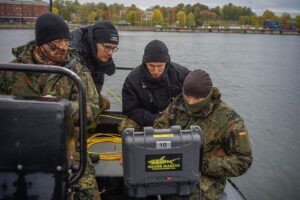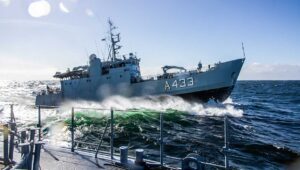
analyse sonar images, Photo: Bw/Thomas Skiba
The close military cooperation in the Baltic Sea region that has been practised for years is now paying off. NATO candidates Finland and Sweden are demonstrating their value to the alliance in securing shipping routes during numerous manoeuvres.
Russia has manoeuvred itself into a highly confrontational position and largely isolated itself internationally with its - by Western standards - value-disrespecting and aggressive actions towards Ukraine. For Russia's direct neighbours, Finland and Poland, but especially the three Baltic states Estonia, Latvia and Lithuania, this has created more than just a theoretical threat to their existence. Crisis and war scenarios of the Cold War, which had actually long been a thing of the past, are once again appearing within the realms of the conceivable.
Once again, the importance of the free shipping lanes, known as Sea Lines of Communication (SLOCs) in military parlance, for the movement of goods in the economy is coming into focus. Added to this is their importance for the deployment of military units and their supply to reinforce and stabilise our eastern partners. While Poland, as a continental state, can be easily supplied and reinforced by land, the importance of the sea route for the three Baltic states is much greater. The planned expansion of the NATO enhanced Forward Presence (eFP) battle groups stationed there to brigade strength will also significantly increase the need for supplies. The land route across the Suwalki Gap, which is only 65 kilometres wide, is considered to be at risk in the event of a conflict.

Wambola, Photo: Bw/Marcel Kroencke
With its Baltic Fleet based in Baltiysk (in the Kaliningrad Oblast) and Kronstadt (in the Gulf of Finland around 30 kilometres from St. Petersburg), Russia has a powerful naval force equipped with state-of-the-art weapons. This is supported by state-of-the-art missile defence systems, including the S-400 type, coastal artillery systems and numerous army and air force units, including from the Russian enclave of Kaliningrad. Even if it is considered isolated and "enclosed" in the Baltic Sea, the Baltic Fleet can have an impact far into the Baltic Sea and threaten the SLOCs there.
Keeping these vital shipping routes open is a joint task for NATO and, first and foremost, of course, for the countries bordering the Baltic Sea. The expectations of the alliance partners towards the largest navy in the Baltic Sea region, the German Navy, are justified. Germany has been aware of the responsibility this entails since before the Russian attack on Ukraine last year. It has been striving to assume a leadership role for years. With the Baltic Commanders Conference initiated by Germany in 2015, in which all Baltic Sea states including Norway, but excluding Russia, are represented, a platform was created to intensify coordination and cooperation between the navies in the Baltic Sea region.
Grown co-operation
Co-operation between seaborne and land-based units in the Baltic Sea region can look back on a long development and tradition. The established cooperation within the framework of the NATO standing task forces is just one of the constants. Regular large-scale manoeuvres such as Baltops, Northern Coasts or Open Spirit have been connecting the navies of the northern NATO states and their partners in the Baltic Sea region for years. As part of the Partnership for Peace (PfP), the future NATO member states Finland and Sweden were involved in exercises at an early stage after the end of the Cold War.
Side note: Russia has also been a member of this partnership since it was ratified by the Duma in 2007. However, this relationship can currently be described as dormant.
From the perspective of NATO and the EU, as well as every other democratic state, the start of the war in Ukraine represents an acute threat to the value-based international order. It is obvious that the course and especially the outcome of this war will have an impact on the future of the European and global security architecture. This substantial, united and therefore highly effective support of all Western states for Ukraine - without direct military involvement - resulted in a reawakened awareness that the alliance can only stand together against any aggression. This Western unity is seen as the key to maintaining security in Europe. The importance of increased cooperation, intensified relations and significant investment in strengthening the armed forces for national and alliance defence is emphasised everywhere. In practice, it is primarily about reviewing and adapting structures and prepared plans, but in particular about visible and joint signals of unity and unity.
Vigilance activities, as they are known in NATO jargon, were immediately stepped up in the Baltic Sea. These fundamental military measures by NATO forces serve to gain and maintain an appropriate strategic situational awareness in the alliance area and to ensure the operational readiness of the armed forces. In addition, NATO provides for enhanced vigilance activities (eVA). This is in response to specific changes in the security situation and shifts in the centre of gravity of our own armed forces, as is currently required on the Alliance's eastern flank.

Germany is aware of its special responsibility in the Baltic Sea and has significantly increased its activities in the Baltic Sea with the eVA Baltic Guard immediately after the start of the war in spring 2022. All available and operational units were sent to sea, and some were even diverted from projects in sea areas further west to the central and eastern Baltic Sea.
Numerous manoeuvres
In this context, the Baltic Mine Countermeasures Exercise (BMCMEx) of the 3rd Mine Detection Squadron should be highlighted. The manoeuvre was originally scheduled to begin and the units to depart on 14 March 2022. In order to support Baltic Guard, the departure took place on 28 February, demonstrating the fleet's cold start capability, and lasted until 1 April. A total of around 600 soldiers took part in this international invitational manoeuvre, including around 450 from Germany. In addition to the five minesweepers of the 3rd Minesweeper Squadron and the three Tenders 404 of the Support Squadron, units from Belgium, Denmark, Estonia, Latvia and Lithuania also took part in the manoeuvre throughout. In addition, mine countermeasure units from Finland and Sweden took part in certain phases of the exercise. In addition to the operational success of the exercise and the extremely positive experience gained by the participating units, the deepening of international relations, particularly at a tactical level, should be emphasised. Even though the ability to cooperate in the area of mine defence has always been good thanks to many years of joint participation in the standing NATO mine defence units, this project showed how quickly an international, operational mine defence unit can be set up - an essential core capability for securing the open sea lanes, especially in the relatively shallow waters of the Baltic Sea.
An even broader range of capabilities was exercised during the Baltops manoeuvre in June 2022. A total of 14 NATO countries and two partner countries cooperated in the Baltic Sea for almost a fortnight. In addition to amphibious operations, the focus was on firing exercises, anti-submarine, anti-aircraft and anti-mine defence. With around 45 ships and boats, 75 aircraft and around 7000 soldiers involved, Baltops had an impressive scope this year. The number of sea-going units was the largest since it was first organised in 1971, with Germany participating with the frigate Sachsen, the corvette Braunschweig, the task force provider Berlin and the minehunting boats Fulda and Homburg, as well as various aircraft. At this time, it would have been impossible to send a clearer signal of unity and cooperation to Russia.
On a different scale, but with the same idea of cooperation, the Northern Coasts manoeuvre led by Germany took place in September. In addition to general force integration, the focus was on anti-submarine and mine defence. From Germany, the frigate Schleswig-Holstein was involved as a command platform with two on-board Sea Lynx helicopters, the fleet service boat Oste, the minehunting boat Bad Bevensen with an embarked US minehunter team, U 32, the tender Elbe and the naval aviation squadron with numerous P-3C missions. Internationally, an American Arleigh Burke-class destroyer and mine countermeasure units from France, Estonia, Latvia and Lithuania took part. Maritime surveillance flights by American P-8As supported the situation picture and contributed significantly to the success of the training for all participants.
Baltic Tiger 22, a multinational, joint force exercise with a different focus, took place in Estonia in October. In addition to the naval battalion with marines, mine divers and medical personnel, the air force's object protection regiment and the navy's North Sea NBC defence platoon and numerous units from the Estonian hosts, Danish and British forces were also involved. The focus was on protecting important infrastructure, such as the NATO airfield in Ämari, from where German Eurofighters contribute to the increased air policing in the Baltic region. Close air support procedures were also practised. The manoeuvre underlined the excellent cooperation between NATO units with a direct link to the protection of NATO's eastern flank.
The last major international manoeuvre of the year, Freezing Winds 2022, took place in November and December. It was the largest maritime manoeuvre ever conducted and led by Finland with international participation. In total, forces from twelve nations and up to 5,000 soldiers were involved. With a regional focus on the Gulf of Finland and the archipelago, cooperation between maritime units and coastal defence forces was practised and expanded. Among other things, the numerous mine countermeasure units with the participation of the VJTF (M), the SNMCMG 1, including the Mosel tender and the Sulzbach-Rosenberg minehunting boat, as well as the Dillingen minehunting boat operating for Baltic Guard, made an important contribution to securing the SLOCs in the Baltic Sea. During Freezing Winds, it became clear that the future NATO member is excellently equipped thanks to its many years of participation in joint projects and regular cooperation and represents a strengthening of NATO in the East.
Conclusion
The close proximity of the Baltic Sea and the proximity of the partners has made it possible in the past to regularly and intensively train and further develop the comprehensive spectrum of military capabilities together. As a result of the united response of the Western allies from NATO and the EU to the Russian attack on Ukraine, the ability to conduct joint and cross-force operations has become increasingly important. Independent of larger manoeuvres planned well in advance, Germany's Baltic Guard offers a consistent framework for the continuation and intensification of short-term cooperation projects - bilateral or multilateral - and thus also underpins its claim to a leading role in the Baltic Sea region.
Frigate Captain Thorsten Klinger works in the Operational Flotilla 1, Naval Mine Warfare Capability Development.
Thorsten Klinger










